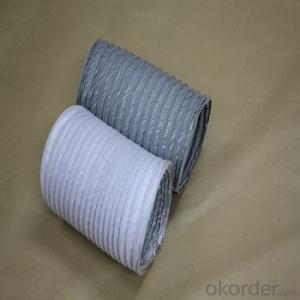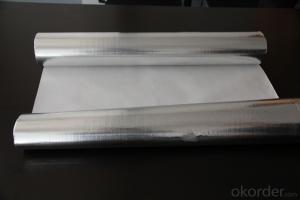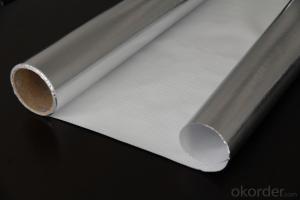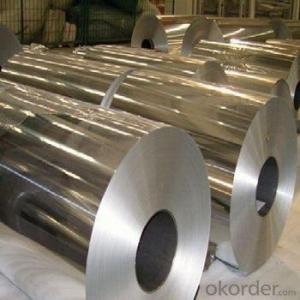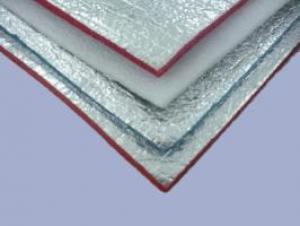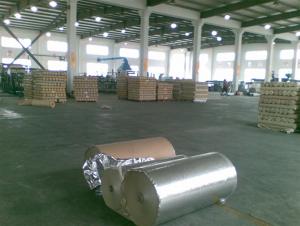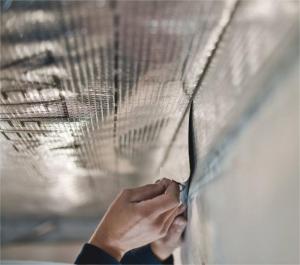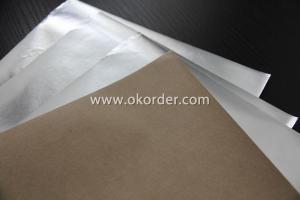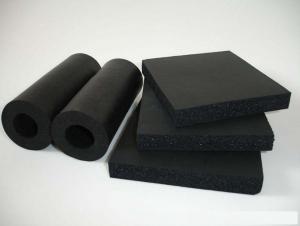Aluminum Foil Facing Insulation for Roofing Wall Vapor Barrier
- Loading Port:
- Shanghai
- Payment Terms:
- TT OR LC
- Min Order Qty:
- 500 m²
- Supply Capability:
- 6000000 m²/month
OKorder Service Pledge
OKorder Financial Service
You Might Also Like
Specification
1. Aluminum Foil Facing Description:
The production technologies and products performance of aluminum foil facing have been up to international advanced level. The aluminum foil facing products are mainly used for HVAC system, refrigerators, building thermal aluminum foil facing insulation and laminated with glass wool and rock wool to increase the insulation function.
• Heat-sealing aluminum foil facing is used for duct wrap without applying extra adhesive and suitable for online lamination of glass wool and rock wool.
• FSK aluminum foil facing is mainly used for duct wrap in HVAC system and other fields, such as vapor barrier etc., and suitable for off-line lamination of glass wool or rock wool.
• The WPSK aluminum foil facing, whose structure is white polypropylene/ fiberglass scrim/ kraft is mainly used for metal building insulation and suitable for the insulation of ware-house, factory, supermarket, office and so on.
2.Main Features of the Aluminum foil facing:
• Light weight
• Small inertia resistance
• High manufacturing accuracy
• Strong heat dissipation ability
• Good visual effect
• environmentally friendly,no smell and not-toxic;
• Smooth and clear surface;
3.Aluminum Foil Facing Images

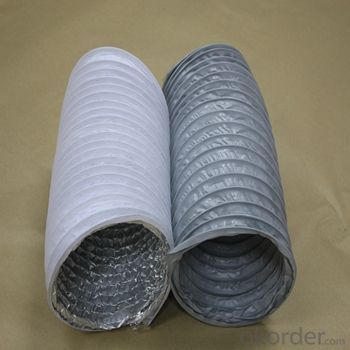
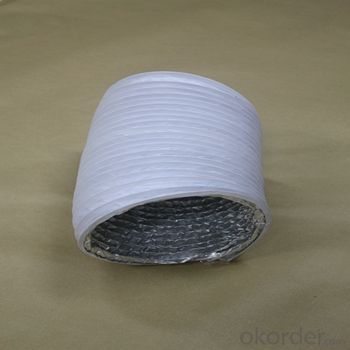
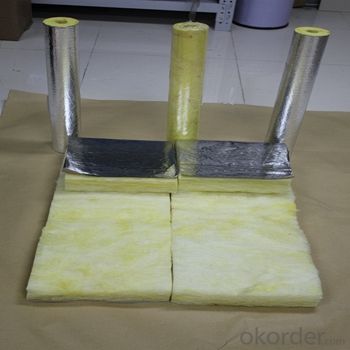
4.Aluminum Foil Facing Specification
Width: 1.0m, 1.2m, 1.25 m, 1.30, 1.37m
Length: 200m, 500m, 1000m, 2500m, 2750m, 3300m
Core I.D.: 3"(76mm ±1), 72mm ±1
Based on order, special sizes are also available.
5.FAQ
We have organized several common questions for our clients,may help you sincerely:
(1) How about your company?
A world class manufacturer & supplier of aluminum foil facing and is one of the large-scale professional investment aluminum foil facing bases in China. Annually more than 1000 containers of aluminum foil facing are exported to markets in Europe, America and Japan.
(2)What is the storage condition?
The products should be stored at room temperature and kept from wet and heat source.
It is essential, as with all pressure-sensitive tapes, that the surface to which the tape is applied must be clean, dry, and free of grease and oil.
The user should take test and do trial-application on the above products before coming into application so as to witness and ensure suitability for user’s special purpose and technique.
- Q: Is it possible to use aluminum foil with a reflective side for food freezing purposes?
- <p>Yes, aluminum foil facing can be used for freezing food. It helps to maintain the temperature and prevent freezer burn by acting as a barrier to air and moisture. However, it's important to ensure that the foil is food-grade and does not have any sharp edges that could puncture the food packaging. Additionally, it's recommended to wrap the food securely in the foil to minimize air exposure and maximize the preservation of the food's quality and taste.</p>
- Q: Is it safe and practical to use aluminum foil facing as a protective layer for a cutting board?
- <p>Yes, you can use aluminum foil facing as a temporary cover for a cutting board. It provides a smooth surface that can protect the cutting board from scratches and stains. However, it's not recommended for long-term use or heavy-duty cutting as it may tear or dent easily. For regular use, a proper cutting board cover or a plastic cutting mat is more durable and safer.</p>
- Q: Is it possible to create a pie crust using aluminum foil as a substitute for traditional pie crust materials?
- <p>No, you cannot use aluminum foil to make a pie crust. A pie crust is traditionally made from flour, butter, and water, which when combined and baked, create a flaky, edible crust. Aluminum foil is a metal material not meant for consumption and lacks the properties needed to form a pie crust. It does not have the ability to be rolled out, shaped, or baked into a flaky, edible form. Instead, it's used for wrapping food to retain moisture or for cooking on a grill.</p>
- Q: Can aluminum foil be utilized as a facing material for cooking in a microwave oven?
- <p>Aluminum foil facing should not be used for microwave cooking. Microwaves can cause the foil to heat up and potentially create sparks or even start a fire. It can also reflect microwaves, damaging the microwave's interior and potentially the oven itself. Always use microwave-safe materials, such as glass or microwave-safe plastic containers, for cooking in a microwave.</p>
- Q: This question asks for a method to clean aluminum foil after cooking to get rid of excess oil.
- <p>To remove excess oil from aluminum foil after cooking, first let the foil cool down to avoid burns. Then, you can use a paper towel or a clean cloth to gently wipe away the oil. For stubborn oil, you can wash the foil with warm soapy water. If you're reusing the foil, make sure it's thoroughly dried before storing to prevent any potential for bacterial growth. Always remember to handle aluminum foil with care as it can be sharp and may tear easily.</p>
- Q: What are the chemical characteristics of the side of aluminum foil that faces outwards?
- <p>The chemical properties of the aluminum foil facing outward are primarily determined by its elemental composition, which is aluminum (Al). Aluminum is a lightweight, soft, and malleable metal with a silvery-white appearance. It is highly reactive and readily forms a thin, protective oxide layer (aluminum oxide) when exposed to air, which prevents further oxidation. This oxide layer is what gives aluminum foil its resistance to corrosion and its shiny appearance. Aluminum is also a good conductor of heat and electricity. The facing side of the aluminum foil may have slight differences in properties due to the manufacturing process, but fundamentally, it remains chemically similar to the rest of the aluminum foil.</p>
- Q: Is it safe to use aluminum foil facing for storing perishable foods like milk or yogurt?
- <p>Using aluminum foil facing for storing perishable foods like milk or yogurt is generally safe. Aluminum foil doesn't react with these foods and can help maintain freshness by providing a barrier against light and air. However, it's important to ensure that the foil is food-grade and that the container is properly sealed to prevent contamination. Always check the foil for any tears or punctures that could compromise the integrity of the seal. Additionally, avoid using aluminum foil in direct contact with acidic foods as it may cause a reaction over time.</p>
- Q: This question asks for advice on how to use aluminum foil effectively in the kitchen.
- <p>Using aluminum foil efficiently in the kitchen can save time and resources. Here are some tips: 1. Pre-cut and store: Keep a roll of aluminum foil in the kitchen and pre-cut pieces for quick use. 2. Double layer for insulation: Use a double layer for wrapping food to retain heat and keep food warm for longer. 3. Line baking sheets: Line baking sheets with foil to prevent sticking and make cleanup easier. 4. Cover dishes: Use foil to cover dishes in the oven to prevent over-browning. 5. Use for grilling: Wrap vegetables or fish in foil for easy, mess-free grilling. 6. Reuse: Reuse aluminum foil for multiple tasks to minimize waste. 7. Avoid overuse: Use only as much foil as needed to prevent unnecessary waste. 8. Recycle: Always recycle aluminum foil after use to contribute to sustainability.</p>
- Q: Can aluminum foil be used as a material for crafting a pot holder or pot lid holder?
- <p>While aluminum foil is heat resistant to a certain extent, it is not recommended for making a pot holder or pot lid holder due to its low melting point and potential to conduct heat, which could lead to burns or damage to the foil. Instead, consider materials designed for heat resistance such as silicone, fabric with heat-resistant properties, or insulated materials specifically made for kitchen use. These materials are safer and more effective for handling hot pots and lids.</p>
- Q: Explain the differences between aluminum foil facing and plastic wrap when it comes to storing food.
- <p>Aluminum foil facing and plastic wrap are both used for food storage, but they have distinct properties. Aluminum foil facing is a moisture-resistant barrier that reflects heat, making it ideal for cooking and reheating food in the oven or microwave. It's also good for sealing in freshness and preventing freezer burn. Plastic wrap, on the other hand, is a clingy film that tightly seals around food to keep it fresh. It's transparent, allowing you to see the contents, and is useful for covering dishes and bowls. However, it's not heat resistant and can melt or release harmful chemicals when heated, so it's not suitable for cooking or reheating food.</p>
Send your message to us
Aluminum Foil Facing Insulation for Roofing Wall Vapor Barrier
- Loading Port:
- Shanghai
- Payment Terms:
- TT OR LC
- Min Order Qty:
- 500 m²
- Supply Capability:
- 6000000 m²/month
OKorder Service Pledge
OKorder Financial Service
Similar products
Hot products
Hot Searches
Related keywords
